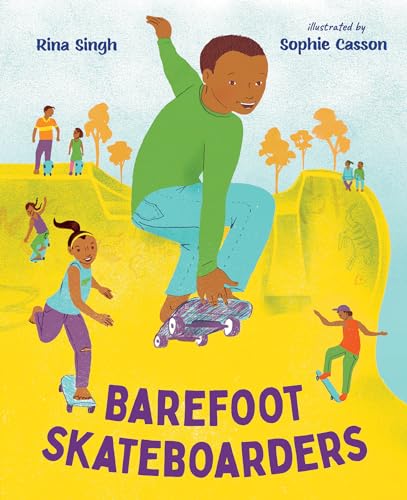Barefoot Skateboarders

Barefoot Skateboarders
The sport of skateboarding, which originated with surfers in California in the 1940’s, seems to have captured the imagination of adventuresome types the world over. Even in the small Indian village portrayed in this book, where two social groups live side by side but separately, the new activity has taken hold.
Hidden in the heart of India lies Janwaar, a remote village.
A single unfinished road runs through it. On one side live
the Yadavs, who own farmland and have brick homes.
On the other side are the Adivasis, Indigenous people who
work as farm laborers and have mud houses.
Ramkesh, who is Adivasi, is intrigued by the newly-built skate park and especially by the antics of the Yadav boys who seem to have quickly acquired boards and colourful sports shoes. He would love to try emulating them, but he has no board – and no shoes. When a woman named Ulrike, who is some type of foreign aid worker, offers Rankesh his own skateboard, he is willing to give it a whirl, shoes or not.
Ramkesh looks down at his dusty bare feet and jumps on the board.
He tries to balance and copy their moves. He falls, scrapes his knees
and falls again. But every time, he picks himself up. He wants to fly too.
Some other barefoot Adivasi join in, and soon the skate park is full of boys, with and without shoes, showing off their moves. But what about the girls? Ramkesh asks his sister Durgha if she wants to take a turn, and it is not long before other girls are getting in on the fun.
The village begins to fill with the laughter and shrieks of barefoot
children and the clickety-clack of the skateboards. Ramkesh is
getting really good.
It’s so much fun that some children start skipping school to be at
the park. And a new rule goes up.
No School, No Skateboarding.
From a pastime that has united a neighbourhood, skateboarding becomes something that propels several kids into international competition. It takes three Adivasis - two boys and one girl - to England and Germany. With the passports necessary for their travel come the first pairs of their own flash footwear.
Skateboarding in this huge arena shows them how much they still can learn in mastering the sport.
The children come back home humbled but energized,
and with new dreams – for themselves and for the village.
Ramkesh, Asha and Arun bring the villagers together with their
newfound confidence. Everyone is proud that the world knows about
Janwaar. For the first time in their lives, the elders let their children
lead the way.
The last two pages tell readers that Ramkesh’s story is true, one inspired by German activist Ulrike Reinhard’s initiative which had international artists donating the proceeds from the sale of custom-decorated skateboards to build the Janwaar skatepark. The author travelled to see this community renaissance for herself and to write the book in response.
Quebec artist Casson’s simple illustrations, done “in hand-drawn pencil… with textured overlay, such as handmade stamps or stenciling”, capture not just a small, dusty Indian village but also the energy and activity around the skatepark and the joyful expressions of all who become involved in this remarkable change. I loved the somewhat abstract picture of the crowded escalators at a busy airport facing a page clearly showing Ramkesh and Arun on their first plane ride, one pointing out the window and one looking down with excitement at his new shoes.
If I had not read Singh’s afterword, I would have thought the story almost too good to be true, especially in the way that girls become participants in the sport and in the complete lack of any adult conflict during the whole undertaking. Although Barefoot Skateboarders may lack some immediate appeal for individual readers scanning library shelves, the book would be a useful springboard for discussions on, at one level, community-building and on another, the many ways that international sponsors can effect change.
Ellen Heaney is a retired children’s librarian living in Coquitlam, British Columbia.
